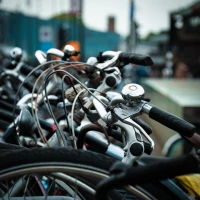The modern cyclist is constantly seeking new ways to push the boundaries of speed and efficiency. Electric bicycles, or e-bikes, have emerged as a beacon of innovation in the cycling world, offering riders a blend of traditional biking and enhanced speed capabilities. As a rider, knowing the extent of the speed you can achieve with your e-bike is crucial to both your enjoyment and safety. In this detailed exploration, we will dive into the world of electric bicycles and discover just how fast they can propel you on your adventures.
The Potential of E-Bike Speeds
Electric bicycles have introduced an exciting dynamic to the world of cycling, with their ability to power through roads and trails at impressive speeds. The potential speed of an e-bike can vary significantly based on its design, mode, and the regulations of the area in which it is used.
Understanding the Different Classes of E-Bikes
E-bikes come in various classifications that can impact their maximum speed. Here are the common classes:
- Class 1: Pedal-assist without a throttle; max speed of 20 mph.
- Class 2: Throttle-assisted with a max speed of 20 mph, regardless of pedaling.
- Class 3: Pedal-assist only, with no throttle and a top speed of 28 mph.
By understanding these classifications, riders can make informed decisions about the type of e-bike that best suits their need for speed.
The Influence of Motor Power
The motor is the heart of the e-bike’s speed capabilities. Typically, e-bike motors range from 250 watts to over 750 watts. The more powerful the motor, the higher the top speed and acceleration the e-bike can reach, ultimately influencing how fast you can go.
Battery Capacity and Speed
A battery’s capacity, measured in watt-hours (Wh), is directly related to how long an e-bike can maintain its top speed. A higher capacity battery enables longer rides at peak speeds without needing to recharge, allowing riders to unleash their e-bike’s full potential.
Electronic Speed Limiters: Keeping Safety in Check
One critical factor that influences how fast an electric bicycle goes is the presence of electronic speed limiters. These built-in mechanisms prevent the bike from exceeding a certain speed to comply with legal standards and promote safe riding.
Legal Regulations and Their Impact
Different regions have specific laws that govern the top speeds of e-bikes. For example, in the United States, the Consumer Product Safety Act defines an e-bike as a bicycle with a top assisted speed of 20 mph when powered solely by the motor. Abiding by these regulations not only ensures the legality of your ride but also helps maintain a secure riding environment.
Customization and Modification
Despite the existence of speed limiters, some riders opt to modify their e-bikes to bypass these restrictions. However, this can pose significant safety risks and legal repercussions. It is crucial to consider the consequences of such modifications before pursuing higher speeds.
Maximizing E-Bike Speed: Tips and Strategies
For those looking to get the most out of their electric bicycle’s speed capabilities, there are both simple adjustments and advanced techniques that can be utilized.
Optimize Tire Pressure for Speed
One of the easiest ways to enhance your e-bike’s speed is by ensuring the tires are inflated to the recommended pressure. Properly inflated tires reduce rolling resistance, allowing you to glide at higher speeds with less effort.
Aerodynamics and Rider Position
By improving the aerodynamic profile of both the e-bike and the rider, you can significantly reduce drag. Adopting a more aerodynamic riding position and using streamlined accessories can make a noticeable difference in how fast an e-bike can travel.
Regular Maintenance for Peak Performance
Routine maintenance of your e-bike can prevent energy losses due to mechanical inefficiencies. Keeping the drivetrain clean and well-lubricated, ensuring brake pads aren’t dragging, and regularly checking for any loose components all contribute to a swift and smooth ride.
E-Bike Speeds in Real-Life Scenarios
While the technical aspects of e-bike speeds are important, real-life applications provide a clearer understanding of how these machines perform under different conditions.
On Urban Streets: Maneuvering Through Traffic
Navigating urban environments often means dealing with stop-and-go traffic. Here, the acceleration capabilities of e-bikes shine, allowing riders to reach optimal speeds quickly and safely merge with traffic.
Off-Road Adventures: Tackling Challenging Terrains
Off-road electric bicycles are designed to handle rough terrain and inclines. While they may not achieve the same top speeds as on flat pavement, their torque and power offer a thrilling and fast-paced off-road experience.
Long-Distance Touring: Sustaining High-Speed Travel
For long-distance touring, e-bikes with substantial battery capacity can maintain higher speeds over extended periods. This results in reduced travel times and an exhilarating sense of velocity throughout the journey.
The Future of Electric Bicycle Speeds
Advancements in technology continue to push the boundaries of how fast an electric bicycle can go. With continuous improvements in battery efficiency, motor performance, and aerodynamic design, we can expect future e-bikes to surpass current speed expectations.
Emerging Technologies Boosting Speed
Innovations such as lighter materials, more efficient motors, and enhanced battery technologies are contributing to the rise in e-bike speeds. These developments promise an exciting future for speed enthusiasts in the cycling community.
The Role of Legislation in E-Bike Speeds
As e-bikes become faster and more widespread, legislators are faced with the challenge of updating regulations to keep pace with technology while ensuring public safety. Riders must stay informed about changes in laws that could affect how fast they can legally and safely ride their e-bikes.
Conclusion: The Fast Lane of Cycling Evolution
In conclusion, the question of “How fast does an electric bicycle go?” is multi-faceted. Several factors contribute to an e-bike’s speed, including its class, motor power, battery capacity, and legal regulations. By understanding these elements and using proven strategies to enhance speed, riders can fully enjoy the swift and exhilarating performance of their electric bicycles while respecting safety standards. As technology advances, we can anticipate electric bicycles to continue to evolve, offering even greater speed possibilities for the cycling enthusiasts of tomorrow.
Riding an electric bicycle is about embracing innovation and the joy of cycling. Whether you’re commuting through the bustling city, exploring rugged trails, or setting out on long-distance tours, the speed of your e-bike adds a thrilling dimension to the experience. With careful consideration of the technical and regulatory aspects of e-bike speeds, you’re ready to unlock the full potential of your ride and unleash the thrill of speed like never before!
If you’re intrigued by the burgeoning world of e-bikes and their capabilities, embracing the evolution of speed in the cycling realm becomes not just a hobby but a lifestyle. In the brisk pace of modern life, where every second counts, your electric bicycle stands as a testament to progress and an exhilarating way to keep pace with the world around you.










